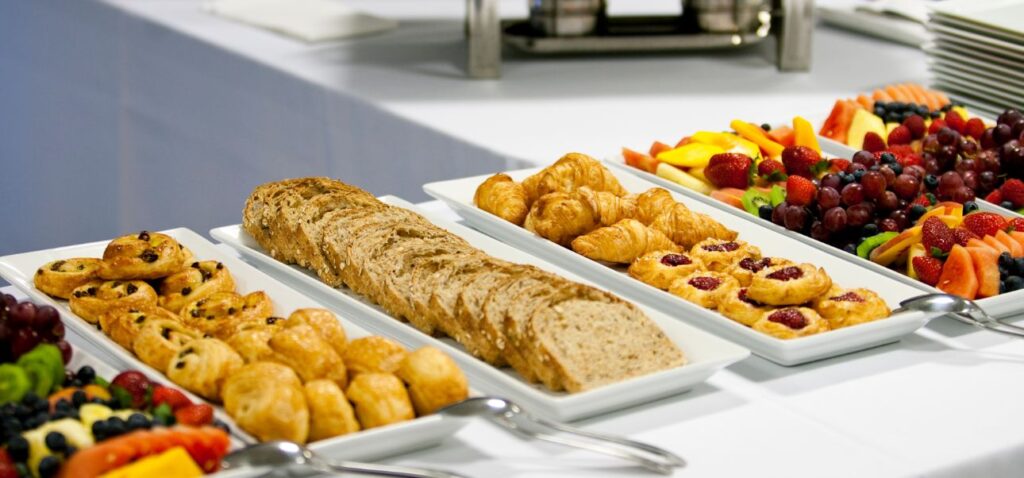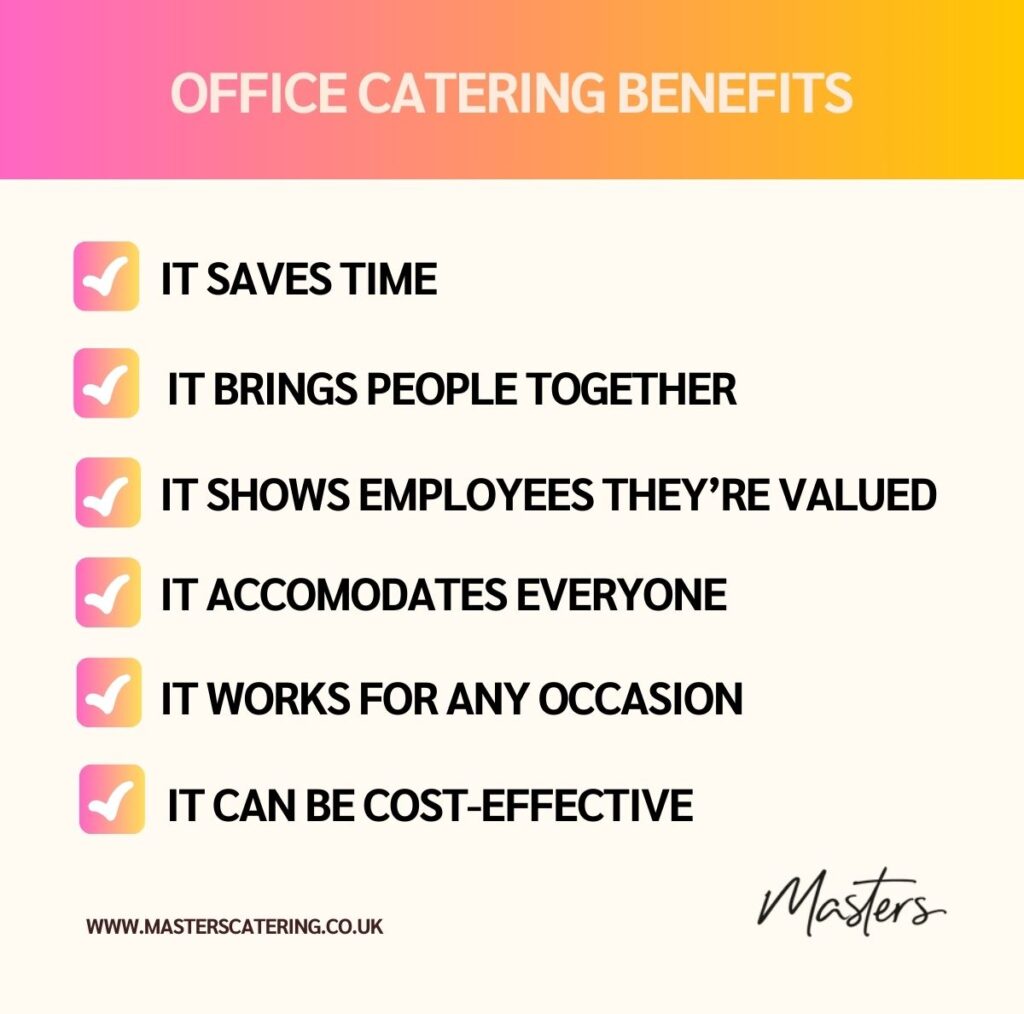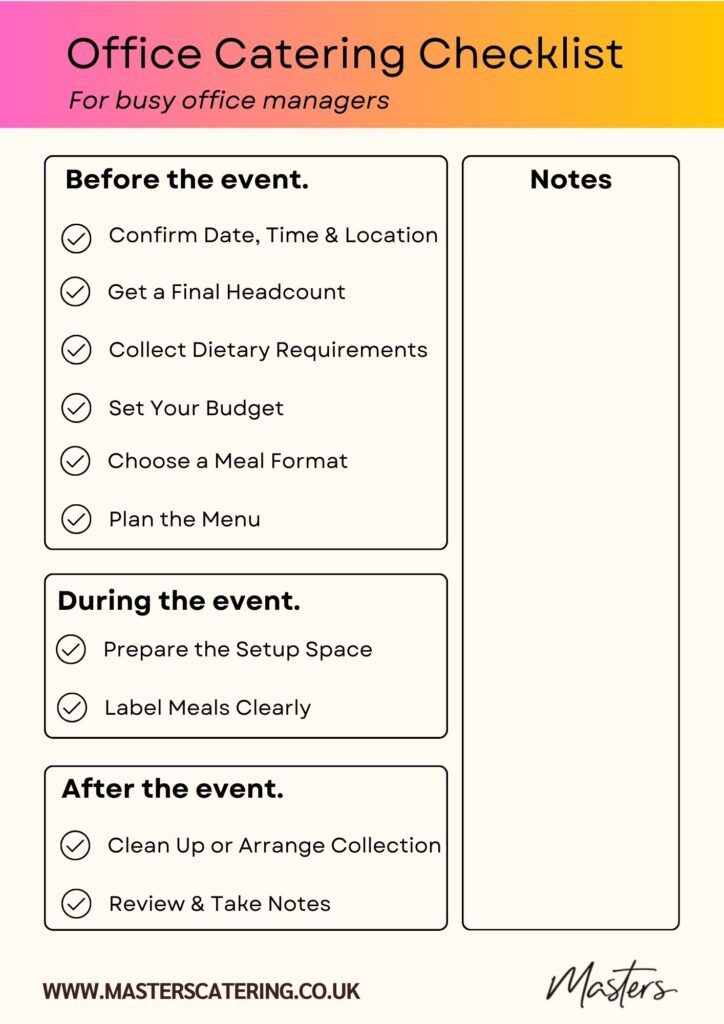Office Catering: Complete Guide For Office Managers (+ a Checklist For Your Next Event)
Office catering isn’t easy. It only sounds easy until you’re the one in charge of organising it.
Between dietary requirements, delivery logistics, and keeping everyone happy, and choosing the best company, office catering can quickly feel like more hassle than it’s worth.
That’s where a bit of planning (and hiring quality office caterers) goes a long way.
This guide breaks down everything you need to know about office catering. From the different types of catering available to common mistakes to avoid, it’s designed to help office managers, PAs, and anyone else in charge of feeding a team get it right without the stress.
Before we get started, first things first.
What is Office Catering? (And What Does It Actually Include?)
Office catering is exactly what it sounds like. Food that’s delivered (or sometimes served) directly to your workplace.
But it’s not just about lunch.
Depending on the occasion, office catering can include everything from early morning breakfasts to after-work drinks in a range of different styles. Before we review the different types of office catering, we know you have one burning question.
How much does it all cost… well, here’s a ballpark.
Many London offices spend around £12 to £20 per person for a solid catered lunch. Breakfast and snacks often cost less.
If you’re ordering regularly, most caterers (including us) can help build a setup that fits your budget.
As a quick FYI, this calculator is just for your general knowledge. For an actual quote, please contact us.
How Much Does Office Catering Cost?
It depends on a few key factors, but having a rough idea helps when you’re planning ahead or working with a set budget. Use this calculator to get a ballpark idea of what you can expect to pay.
The final cost can be influenced by:
- Number of people. Most catering services price per person. The more people you’re feeding, the more flexible pricing tends to be — but even small orders can be cost-effective with the right setup.
- Type of meal. Cold food like sandwich platters and salads usually costs less than hot meals. Breakfast is often more affordable than lunch or dinner. Snacks and desserts can be added for a small extra charge.
- Dietary requirements. Catering for dietary needs doesn’t always increase costs, but more customised orders (like individual boxed meals) can sometimes be slightly higher due to prep and packaging.
- Style of Service. Drop-off catering is usually the most affordable. If you want staff to serve, set up, or stay on-site, expect to pay a bit more for that hands-on experience.
- Delivery and Location. Some catering companies include delivery within a set radius. If your office is further out or requires special access (like timed loading bays), there may be an extra fee.
Now that you’ve got an idea of costs, we can get to talking about the different types of office catering.
Different Types of Office Catering
Breakfast Catering
Breakfast catering is a simple way to start the day on the right note. It’s perfect for early meetings and busy mornings or for giving people an extra reason to come into the office.
Typical options include breakfast packages, toast & bagels, pastry boxes, fruit platters & yoghurt, breakfast wraps, or even a full cooked breakfast for something more substantial.

Lunch Catering
Lunch is easily the most popular type of office catering. It works for everyday team meals, client meetings, or larger events.
Menus usually range from sandwich platters and salad bowls to hot meals or individually boxed lunches. Boxed options are especially useful for meetings or when you need to cater for dietary requirements.
Snack and Dessert Catering
Snacks and sweet treats are an easy win when you want to break up the day or celebrate a small milestone.
Options can include tortilla chips, crisps, breadsticks, dips, and more. Ofcourse, you can also choose healthy snacks.
After-Hours or Drinks Catering
Catering doesn’t have to stop at lunch. For team socials, client events, or after-work drinks, catering might include grazing boards, canapés, sharing platters, or a selection of drinks and cocktails.
It’s a great way to make any event feel more relaxed and social.
Full Event Catering
Full event catering covers everything you need to feed a crowd from breakfast through to evening drinks.
It’s ideal for all-day workshops, conferences, or office parties.
This style of catering often includes multiple meals, snack breaks, drinks, and even on-site staff to handle setup, serving, and clean-up. You can choose from buffet style to full-service catering. Here’s an example of what each includes:
| Format | What It Includes |
| Buffet Style | A variety of dishes laid out for self-serve. Ideal for casual team lunches and larger groups. |
| Individually Boxed Meals | Pre-packed meals for each person, often labeled with dietary details. Great for meetings or teams with dietary restrictions. |
| Sharing Platters / Grazing Tables | Finger foods or small bites served on shared boards or tables. Perfect for socials or drinks receptions. |
| Full-Service Catering | Includes setup, serving staff, and clean-up. Best suited for formal events or when you want a hands-off experience. |
If you’re not sold on office catering yet, then why don’t we talk about some of the benefits?
Benefits of Office Catering
Office catering isn’t just about providing food.
It’s about creating a better workplace experience, building connections, and making life easier for everyone. Plus, people prefer office catering to potlucks. Here are some of the key benefits.

1. It Saves Time
Catering brings food directly to your team, so no one has to waste their lunch break lining up at busy cafes or rushing out for takeaway.
2. It Brings People Together
Sharing a meal is one of the easiest ways to get people talking.
Office catering creates natural moments for teams to connect, chat, and build relationships outside of their usual work routines.
3. It Shows Employees They’re Valued
Providing catered meals, even occasionally, shows that a company is willing to invest in its people. It’s a small gesture that can have a big impact on morale.
4. It Accommodates Everyone
A good catering setup makes it easy to offer vegetarian, vegan, halal, gluten-free, or allergy-friendly options — without the hassle of organizing multiple separate orders.
5. It Works for Any Occasion
Whether you need breakfast for an early meeting, lunch for a workshop, or snacks for a team social, catering is flexible enough to fit almost any situation.
6. It Can Be Cost-Effective
Ordering catering for a group is often cheaper (and far easier to manage) than reimbursing individual meals or letting everyone order separately.
Of course, getting the most out of office catering means planning it properly.
Before you place your next order, here are a few things to consider to make sure it goes smoothly.
Things to Consider When Booking Office Catering
Ordering office catering isn’t difficult, but getting it right does take a little planning. Here are the key things to think about before placing your order.
To help you stay organised, we’ve also created a checklist.

Headcount Matters
Always get an accurate headcount. It sounds obvious, but over-ordering leads to waste, and under-ordering leaves people hungry. If in doubt, round up slightly — especially if you’ve got a hungry team.
Dietary Requirements
Make sure to ask your team about any dietary needs in advance. Common considerations include vegetarian, vegan, halal, gluten-free, dairy-free, or specific allergies. A good catering company will label everything clearly and offer flexible options.
Meal Format
Think about how you want the food served:
- Buffets work well for casual lunches and larger groups.
- Individually boxed meals are great for meetings, training days, or teams with lots of dietary requests.
- Sharing platters are ideal for more social setups like team drinks or networking events.
Delivery Timing
Timing is everything. Consider when you want the food to arrive, and whether it needs to be hot, ready to eat, or set up by the catering team. Always allow a buffer for delivery and setup.
Setup and Clean-up
Some catering companies offer full setup and clean-up. Others provide drop-off only. Make sure you know what’s included so you’re not left clearing tables or hunting for extra plates last minute.
Space and Equipment
Check if you have enough space to lay everything out comfortably. Buffets need tables. Hot food might need plugs for warmers. Boxed meals just need fridge space until you’re ready to eat.
Thinking through the details ahead of time can make all the difference when it comes to stress-free catering.
However, even when you plan ahead, sometimes it’s easy to make common mistakes.
Common Mistakes to Avoid When Ordering Office Catering
Even the simplest catering orders can go sideways if a few small details get missed. Here are some of the most common mistakes, and how to avoid them.
Not Asking About Dietary Requirements
One of the easiest ways to make your catering flop is forgetting to check for dietary needs. Always ask your team in advance and share the details with your caterer. It saves awkward moments and ensures everyone feels included.
Underestimating How Much Food You Need
Nobody wants to fight over the last sandwich. If you’re unsure, it’s often better to round up slightly, especially if the food is likely to be popular or if you have a team with big appetites.
Overcomplicating the Order
It’s tempting to create a fully customised menu for everyone, but simple often works best. A good caterer can help you choose options that work for most people, with a few specific add-ons for dietary needs.
Forgetting About Timing and Delivery Access
Check the practical details before ordering:
- Can the delivery driver easily access your building?
- Is there a service entrance?
- Will you need to book a delivery slot with your building’s concierge?
- What time do you actually want the food to arrive?
Not Planning for Setup and Clean-up
Some caterers deliver and leave. Others will set everything up for you. Either way, know what to expect so you’re not scrambling for cutlery, napkins, or bin bags at the last minute
Once you’ve got the basics covered, a few thoughtful touches can take your catering from functional to memorable. Here’s how to make your next office meal feel like more than just food delivery.
Masters Catering Tips: How to Make Office Catering Feel Special
Great office catering isn’t just about what’s on the menu. It’s about the experience.
Small touches can turn a standard lunch into something that feels thoughtful, well-planned, and actually enjoyable. Here are a few simple ways to make your catering stand out.
Add a Sweet Treat or Snack
Dessert always gets people talking. Even adding something small like cookies, brownies, or a fruit platter can turn lunch into a little event. Afternoon snacks like energy bites or mini pastries work just as well for a mid-day pick-me-up.
Label Everything Clearly
Dietary labels aren’t just practical, they’re appreciated. Make it easy for everyone to find their meal, especially if you’re catering for vegetarian, vegan, gluten-free, halal, or allergy-friendly diets.
As an FYI, when you order from us, all meals will be labelled clearly.
Rotate the Menu Regularly
No one wants the same sandwiches every week.
Switch things up with different cuisines, seasonal menus, or themed days.
That’s exactly why we have such a large menu that you can choose from.
Include Drinks or Extras
It doesn’t have to be fancy. Bottled juices, sparkling water, or a tray of coffees can instantly make catering feel more generous.
For morning meetings, adding fresh juices or protein smoothies is always a nice touch.
Presentation Goes a Long Way
How the food looks when it arrives makes a big difference.
Sharing platters laid out nicely, grazing tables, or food arranged by colour or theme always feels more premium, even if the food itself is simple.
Consider Dietary-Friendly Extras
If you know you have vegan, halal, or gluten-free team members, consider adding an extra platter or dessert option just for them. It’s a small gesture, but it makes people feel considered.
Personal Touches
Handwritten labels, a little welcome note, or even naming a platter after an inside office joke adds a bit of fun and personality to the setup.
Planning Catering That Actually Works
Office catering has come a long way from basic sandwich trays. When it’s done right, it brings people together, supports company culture, and makes the workday feel more enjoyable.
Whether you’re ordering lunch for ten or organising catering for a full-day event, the goal is the same. You want good food, thoughtful details, and a setup that works for your team.
If you’re looking for office catering in London that’s easy to manage, flexible to your needs, and consistently well-prepared, we’d be happy to help.
Faisal is the head chef and founder of Masters Catering, but his love for cooking started long before the business ever did. After years spent working in some of London’s busiest kitchens, Faisal saw first-hand how good food has the power to bring people together, whether it’s over a team lunch or a big family celebration.
Today, he leads the team at Masters Catering, helping offices and event planners serve up food that’s fresh, generous, and actually gets people talking. When he’s not in the kitchen, Faisal loves sharing a little of what he’s learned from feeding thousands of people across London. On the blog, you’ll find practical tips on office catering, meal planning, and making food work better for busy teams.
